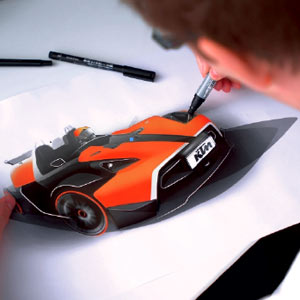

Think about what you desire for a second. What would make you happy, really happy? Sure, I would love to drive a KTM X-Bow. This automobile is the focus of the article called “Establishing a Creative Economy” in the Catalyst issue titled “The DNA for Desire and Design”. This innovative racing machine is the kind of car that Ferraris envy and Hondas want to be, but is that what everyone in this world really desires? Sure the X-Bow was designed and created using unique carbon fiber fabrication techniques and is a fun and exciting track-ready car. People desire this car because its design has created a very fast and agile car. However, at starting price of $88,000 for the entry-level model and tops out at $139,000 for the top-of-the-line GT model, this is an expensive toy that only a small percentage of the world’s population can own. Sure, I’m a car guy and I would love to rip around the Virginia International Raceway in one, but I’m not impressed. This is a weekend toy, no more and no less. Some people desire money and power, or a big house with a pool, but for a big part of the world people desire something more basic, the fundamentals of survival.

What impresses me more is group called WaterWalla. This non-profit company, which was started in 2010 by group of Rhode Island School of Design and Brown University students sought to create a new group of micro-entrepreneurs who can deliver reliable, clean water to the slums of India. Soaib Grewal, RISD Industrial Design; 2011, was the design-lead on the project. Grewal, using his design background, began to see that the issues involved in bring water to these areas of the city was more than a product design issue. In order to solve the problem, he needed to use a creative solution that created a cross-disciplinary process. Working with producer of a simple in-home device that is similar to a Brita water filter. The team devised a plan to pair the filter company with local businessmen. These will be trusted local businesses that understand the neighborhood, in which they operate. The businesses will operate as franchises for the filters and sell them to the people of the slums. This will help bring clean water to those who desire a basic human necessity, clean drinkable water, using an economically viable model.
Waterwalla from Brown PAUR on Vimeo.
Another inspirational example that I recently saw was the story about Isang Litrong Liwanag (A Liter of Light). This sustainable lighting project has brought an eco-friendly and low cost lighting solution to poor communities within Manila and Laguna in the Philippines. Originally designed and developed by students from the Massachusetts Institute of Technology (MIT), it places a plastic bottle filled with water and bleach (to kill the algae) into a small hole that’s cut into the metal roof of their houses. The sunlight enters the bottle and the water refracts the light into the dark room below. This Solar Bottle Bulb allows the people in these neighborhoods to save money on electricity during the daytime hours. This money is then used to buy food. Similar to the X-Bow, the Solar Bottle Bulb was created as a product for a desire, but instead of using modern technology to create the car, the Solar Bottle Bulb uses the principles of Appropriate Technologies. This concept provides simple and easily replicable technologies that address basic needs in developing communities.
All three examples show an integrated design development approach that becomes a strategic component in the implantation of the idea. They all bring future economic value for the people and most importantly, they bring desire to those who use them. However, the X-Bow gives over privileged weekend drivers the thrill of the racetrack but the WaterWalla and the Liter of Light give the under-privileged essentials for life; water, light, and money. These design solutions give their audience hope and desire for the future. This is design strategy that is rooted in creating innovative solutions that solve problems that benefits mankind and create means to distribute desire to those who need it the most.




